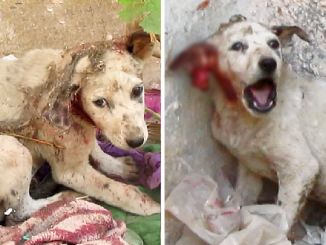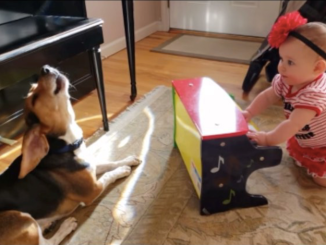In the middle of a military base outside Mexico City, an army colonel runs what he calls a kindergarten for dogs.

In the middle of a military base outside Mexico City, an army colonel runs what he calls a kindergarten for dogs.
Puppies that one day will become rescue dogs, or sniffer dogs for drugs or explosives, get their basic training here, at Mexico’s Army and Air Force Canine Production Center. The puppies are born and spend their first four months at the facility, before being sent to military units around the country for more specialized training.
Founded in 1998, the center has in the past produced breeds such as German Shepherds and Rottweilers.
Now, it exclusively breeds Belgian Malinois — about 300 of them a year.
“It’s a very intelligent dog, it’s a dog with a lot of hardiness, very resistant to diseases,” said Col. Alejandro Camacho Ibarra, a veterinarian and the center’s director. It is the Mexican military’s only such production facility, and Camacho said it may be the largest in Latin America.
The mainly green-and-white, one-story buildings look like any others at the military camp in the State of Mexico, near Mexico City. But the difference here is in the sounds that fill the air: high-pitch barking from dozens of puppies scattered through its maternities and training camps.
Precautions here are strict because of a recent canine parvovirus outbreak that sickened some of the puppies. Visitors are disinfected with a spray, and must step into a watery solution to clean shoe soles. Only military personnel can touch the puppies. If you want to get close, you need to wear scrubs, shoe protectors and a mask, but you still cannot hold or pet the animals.
The training starts early in life, about a month after birth once the weaning process finishes. And everything is taught as a game.
“We start playing with the dog,” Camacho said. The idea is to draw them to items that trainers call “attractors” — like a ball or a rag — and puppies are challenged to catch them. “Every time it holds his prey, it’s rewarded, congratulated, and it learns to go after that prey, after that attractor,” Camacho added.
Unlike in civilian life, where puppies often get food treats, in the military the only prize for a job well done is a caress and some praise.
In one section of the camp, there’s a trail with obstacles including rocks, a tunnel, a section of empty plastic bottles to clamber over, a ladder and tires.
A soldier beckons the little dogs with a rag they must capture. The brown puppies with black snouts begin running through the trail, jumping over the rocks and crossing the obstacles. One takes the lead and the second struggles to cross over the plastic bottles, but also finishes. Both go to bite the rag the soldier holds.
“Very, very good, sons! Very good, boys,” he repeats while dragging the puppies as they maintain their grasp on the rag for several moments.
Camacho explains that the puppies are known by a number until they are three months old, when they are given a proper name. Each year, the center gives names according to a single letter of the alphabet. In 2023, that letter is “F.”
Febo, Frodo, Fósil, Forraje and Fido are some of this year’s names.
The basic training ends when the puppies are 4 months old. Then, they move to other military units to become specialists in detection of drugs or explosive, in search and rescue or in protection and security.
The current government of Mexico’s President Andrés Manuel López Obrador has relied heavily on the armed forces for various initiatives, from public safety to the building of airports and a tourist train line. And K-9 units have been a key element of some of the military’s activities, like the detection of drugs.
Col. Camacho said that some dogs born at the center have been trained to detect fentanyl, a synthetic opioid trafficked by Mexican cartels that has been blamed for about 70,000 overdose deaths per year in the United States.
That kind of specialized training happens elsewhere, but the colonel says it builds on his center’s basic training by using “attractor” objects but having them impregnated with the scent of what the dogs need to track, such as a drug.
Dogs retire from their military service after eight years, Camacho says.

Many of the dogs have become unsung heroes of missions in Mexico and abroad. Occasionally they become publicly known, like a German Shepherd named Proteo who was part of a rescue team sent in February to Turkey after a 7.8-magnitude earthquake that killed more than 40,000 people.
Proteo died during the search for survivors of the quake. A statue of him now stands at the center.
Another dog that made headlines in Mexico and abroad was a yellow Labrador retriever rescue dog named Frida. The Navy dog gained fame in the days following Mexico’s Sept. 19, 2017, earthquake that left more than 300 dead in the capital. She retired in 2019 and died in 2022.
Col. Camacho said that the dogs have a symbiotic relationship with their handlers during their working life in the military.

“The dog uses us to survive, but we also use the dog to do a job,” he said. “So it’s a coordinated work where we both get a benefit.”
p records Incredible journey of kindness: Boy travels hundreds of kilometers to protect homeless dog from sun and rain

In a world often characterized by its fast pace and relentless challenges, there are stories that shine a light on the enduring power of love, determination, and compassion. The tale of a young boy’s incredible journey, carrying his loyal canine companion for hundreds of kilometers, is one such story that has touched hearts around the globe.

This boy, whose identity remains a mystery, found himself in the harsh and unforgiving reality of homelessness. Without a stable shelter or the support of a loving family, he roamed the streets as a wanderer, navigating the challenges of life as best he could. However, amidst the hardships and uncertainties that defined his existence, he discovered an unbreakable bond with a stray dog who became his steadfast friend and confidant.

Witnessing the vulnerability of his four-legged companion and the dangers that lurked on the streets, the boy made a profound and selfless decision. He resolved to embark on a seemingly insurmountable journey, carrying his beloved dog with him every step of the way, in search of a safer and more secure place they could call home.
Under the scorching sun, with sweat on his brow and dust on his shoes, the boy pressed on along dusty roads, carrying the weight of his loyal friend on his tired shoulders. The physical strain was immense, but it paled in comparison to the emotional connection that bound them together. He knew that he was the dog’s only hope, the source of comfort and protection in a world that offered little solace.
When the skies opened up, and the rain poured relentlessly, turning the paths into treacherous, muddy trails, the boy’s resolve remained unshaken. He shielded his furry companion from the elements as best as he could, providing a haven of love amidst the downpour of nature’s tears.
Their arduous journey was a testament to the strength of their bond and the indomitable spirit of the human heart. The boy’s unwavering love for his canine companion fueled his determination, propelling him forward despite the countless obstacles that lay in their path.
News of their remarkable odyssey began to spread, touching the hearts of many who heard their story. Local communities rallied together, recognizing the extraordinary love and determination exhibited by the boy. Shelters and organizations dedicated to animal welfare stepped in, offering them temporary refuge, essential medical care, and the promise of a brighter future.
The boy’s act of carrying his dog for hundreds of kilometers resonated deeply with people across the globe. It shed light on the immense challenges faced by those experiencing homelessness and the unyielding loyalty and love that animals can bring into their lives.
This incredible tale serves as a powerful reminder of the importance of empathy and compassion, not only for our fellow humans but also for the animals that share our world. It prompts us to reflect on the countless individuals who find themselves without a home, as well as the many strays that wander the streets, yearning for love and care.
The boy’s extraordinary journey will forever stand as a testament to the strength of the human spirit and the transformative power of love. It is a story that will inspire generations to come, reminding us of the resilience and compassion that reside within us all, regardless of our circumstances.



Leave a Reply